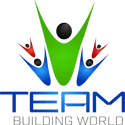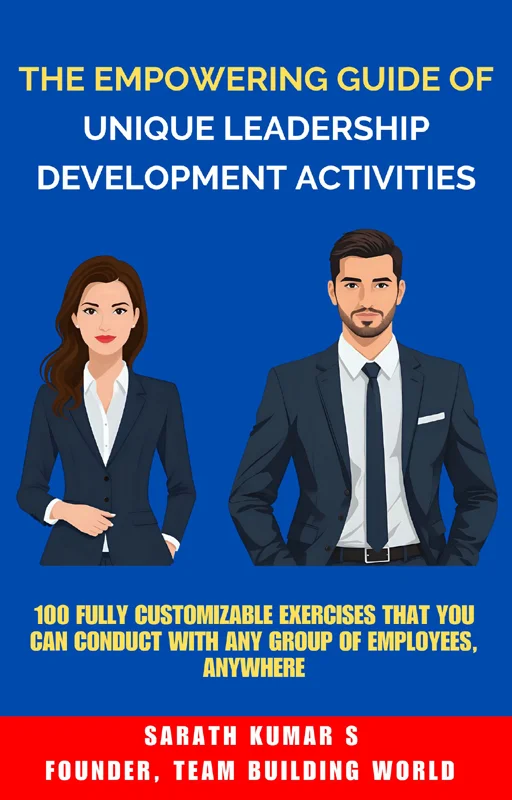10 Team Building Activities with Balls for Adults
Are you in search of some team building activities with balls?
Experiential learning exercises are essential for fostering collaboration, trust, and communication among employees. Using simple equipment like balls, these exercises become engaging and fun while encouraging teamwork in your workplace.
In this article, let’s see 10 effective team building activities you can play using balls. They can help improve coordination, problem-solving skills, and team dynamics.
10 Team Building Activities with Balls for Adults
Here are some team building exercises with balls that are perfect for adults:
#1. Ball Pass Relay
This is a fast-paced activity that focuses on teamwork and coordination. Here teams work together to pass a ball through a defined route as quickly as possible.
Time: 10-15 minutes
Materials: One ball per team
Participants: Minimum 4 people per team
Instructions
- Divide the participants into teams of equal numbers.
- Ask each team to line up single-file and pass the ball overhead to the person behind them.
- Once the ball reaches the last person, they must run to the front and start the process again.
- The team that cycles through all players and finishes the task first wins.
Debrief
Discuss how the team adapted their strategy to improve efficiency. Highlight the importance of communication and synchronization during group tasks.
You can also read: 10 Inclusive Leadership Activities for Your Workplace
#2. Dodgeball with a Twist
This variation of dodgeball adds an interesting twist to the classic game, making it more inclusive and strategic.
Time: 15-20 minutes
Materials: Multiple soft balls
Participants: Need at least two teams of any size
Instructions
- Divide the participants into two teams and set up a playing area with clear boundaries.
- The goal is to eliminate players from the opposing team by hitting them with a ball below the waist.
- However, players eliminated can rejoin the game if their team catches a ball thrown by the opposing side.
- Add a challenge by designating one player on each team as the “guardian,” who cannot be eliminated but must avoid being hit at all costs.
Debrief
Encourage the participants to reflect on how they adjusted their strategies throughout the game. Discuss the value of quick decision-making, trust in teammates, and adaptability in dynamic situations.
You can also read: 10 Balloon Team Building Activities for Your Employees
#3. Catch and Call
This exercise enhances communication, focus, and quick reflexes in a fun and interactive way.
Time: 10-15 minutes
Materials: One lightweight ball
Participants: Minimum 4 people per group
Instructions
- Have the group members stand in a circle, spaced evenly apart.
- One person starts by tossing the ball to another member while calling out their name.
- The person catching the ball must quickly toss it to someone else and call out their name.
- Gradually increase the speed of the game or introduce multiple balls to make it more challenging.
Debrief
After the activity, discuss the role of clear communication and focus. Highlight how calling out names and maintaining attentiveness contributes to better coordination as well as teamwork.
#4. Human Table Soccer
This life-sized twist on the classic table soccer game sparks collaboration and strategy.
Time: You decide
Materials: A large ball (such as a beach ball) and marked zones or ropes to restrict player movement
Participants: Need at least two teams of 2-8 members each
Instructions
- Create a playing field and divide it into zones like a table soccer layout. Assign 2-3 players to a zone per team.
- Players must stay within their zones and pass the ball to teammates in other zones to score a goal.
- The team that scores the most goals within the time limit wins.
Debrief
Reflect on the importance of staying disciplined within assigned roles and utilizing creative strategies to achieve goals. Discuss how effective communication can elevate teamwork.
#5. Capture the Ball
This energetic activity fosters teamwork, strategy, and physical agility.
Time: You decide
Materials: Balls (one per team, preferably a different color for each team) and cones or markers to designate team zones
Participants: Need two or more teams of any size
Instructions
- Set up a field with clearly marked zones for each team and a neutral zone in the center. Place each team’s ball in their respective zone.
- The objective is to capture the opposing team’s ball and bring it back to your own zone without being tagged.
- Players entering an opponent’s zone can be tagged and sent to a designated “jail” within that zone. They can only be released if a teammate tags them.
- If a player successfully captures the ball, it must be carried back to the home zone without dropping or being tagged.
Debrief
Discuss the strategies the teams used to coordinate their offense and defense. Reflect on how trust, communication, and role distribution impacted the game.
#6. Target Toss
This activity encourages precision, strategy, and collaborative effort among teammates.
Time: 10-15 minutes
Materials: Balls of varying sizes and targets (such as buckets or marked circles)
Participants: 2-8 people per team
Instructions
- Set up various targets at different distances, assigning points based on difficulty.
- Each team takes turns tossing balls to hit the targets and score points.
- Teams can strategize which player should attempt specific targets based on their strengths.
- The team with the highest total score at the end wins.
Debrief
Invite the participants to discuss team strategies and how identifying individual strengths helped in achieving collective success. Reflect on the value of planning and adaptability in challenging scenarios.
#7. Group Juggle Challenge
This exercise promotes collaboration, quick thinking, and coordination while adding an element of fun and competition.
Time: 10-15 minutes
Materials: Lightweight balls (such as bean bags)
Participants: Minimum 4 people per group
Instructions
- Have the participants stand in a circle, spaced evenly apart.
- Start by tossing one ball to another participant and gradually increase the number of balls being passed around.
- The goal is to keep all balls going without dropping any for a set time limit (or until one team drops all their balls).
- To make it more challenging, introduce obstacles or require specific passing patterns.
Debrief
Discuss how the group coordinated to keep all balls in motion and any challenges faced. Reflect on the importance of clear communication and trust within a team. Encourage the participants to share the strategies that helped them succeed.
#8. Hot Potato Challenge
This activity is a fun and fast-paced way to foster attentiveness, agility, and teamwork.
Time: 10-15 minutes
Materials: A small, lightweight ball or object to serve as the “hot potato”
Participants: 3-10 individuals per group
Instructions
- Group members should form a circle. Give one person the “hot potato” to start.
- Play music as the participants pass the “hot potato” around the circle as quickly as possible.
- When the music stops, the person holding the “hot potato” is either eliminated or given a small challenge, depending on the agreed-upon rules.
- Continue the game until one participant is left or until a set time limit is reached.
Debrief
Discuss how the participants managed pressure and stayed focused during the game. Highlight the importance of being attentive and making split-second decisions under time constraints. Encourage the participants to share their experience of working collaboratively in a high-energy environment.
#9. Beach Ball Questions
This engaging exercise combines fun, spontaneity, and meaningful conversation. It can build connections and break the ice.
Time: 15-20 minutes
Materials: A beach ball with questions written on it (use a marker or attach questions with tape).
Participants: Groups of 3-8 individuals
Instructions
- Write various questions or prompts on the beach ball (e.g., “What is your favorite hobby?” or “Share a fun fact about yourself”).
- Participants take turns tossing the ball to someone else in the group.
- When a participant catches the ball, they must answer the question closest to where their right thumb landed.
- The game continues until everyone has had a turn or until a set time limit is reached.
Debrief
Reflect on the value of sharing and learning about each other. Discuss how understanding others’ perspectives as well as experiences strengthens connections and enhances teamwork.
#10. Collaborative Story Catch
This creative activity encourages teamwork, active listening, and storytelling skills.
Time: 15-20 minutes
Materials: A ball or object to serve as the “story catcher.”
Participants: Groups of 3-8 individuals
Instructions
- Participants sit in a circle and determine the order of play. The first person starts by tossing the “story catcher” to another participant and beginning a story with one sentence (e.g., “Once upon a time…”).
- Each participant adds one sentence to the story as they catch the “story catcher” and then toss it to someone else.
- The story continues until everyone has had a turn or until a set time limit is reached.
Debrief
Discuss the importance of active listening and building on ideas in a group setting. Reflect on how individual contributions can come together to create something greater as a team.
Want Some Unique Leadership Development Activities?
If you want some unique activities to equip your employees (both in-person and virtual) with leadership skills, qualities, and mindset, you can get my premium e-book:
Or Want Some Unique Team Building Activities?
If you want some unique activities for your employees (both in-person and virtual), you can get my premium e-book:
Final Words
Team building doesn’t have to be complicated to be effective. Using simple tools like balls, these activities bring out the strengths of every team member while creating a positive and collaborative atmosphere. Remember, the key to successful teamwork is understanding and embracing individual differences while working towards a common goal. So, gather your team and have fun while building stronger connections!
FAQ: Team Building Activities with Balls
You might have these questions in mind.
Do these activities require any special skills or equipment?
No, most of these activities only require basic equipment like balls or objects that are easy to find. They do not require any specific skills, making them accessible to everyone.
How often should these activities be conducted?
These activities can be conducted as part of regular meetings or events, depending on your organization’s needs. It is also helpful to schedule these exercises at least once every week or month to maintain strong team dynamics.
How do these activities benefit teams?
These activities help foster essential skills such as communication, trust, collaboration, and problem-solving, which are vital for a successful team. By engaging in these exercises, team members also get to know each other better, leading to stronger working relationships and improved morale. So, don’t hesitate to incorporate these fun and effective activities into your next meeting or event!
How do I ensure that everyone participates?
Create an inclusive environment where everyone feels comfortable and encouraged to join. Clearly explain the rules and emphasize that the activities are designed for fun and skill development rather than competition. Sometimes, allowing participants to pair up or take on smaller roles initially can help ease hesitancy and build confidence.
Are there any age or cultural considerations?
Yes, it’s essential to tailor the activities to your team’s age group and cultural background. Choose games and topics that are universally understood and respectful of everyone’s experiences. If you’re working with a diverse group, provide alternative prompts or adapt the format to ensure inclusivity and enjoyment for all the participants.

